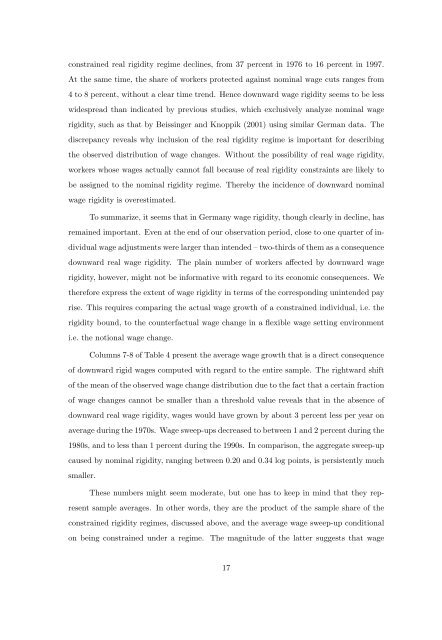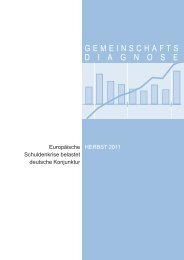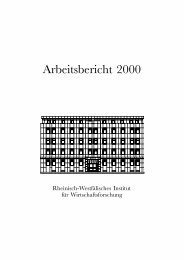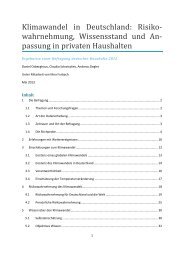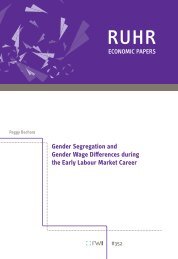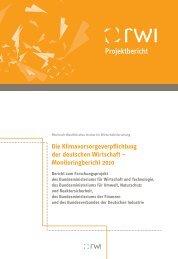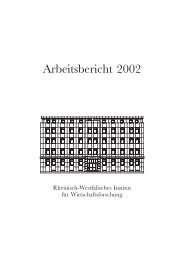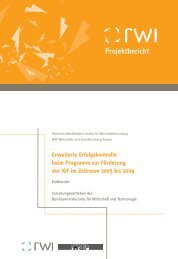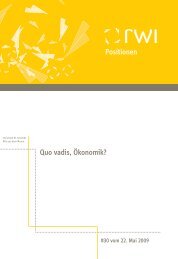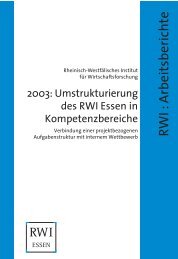RW I:Discussion Papers - Rheinisch-Westfälisches Institut für ...
RW I:Discussion Papers - Rheinisch-Westfälisches Institut für ...
RW I:Discussion Papers - Rheinisch-Westfälisches Institut für ...
You also want an ePaper? Increase the reach of your titles
YUMPU automatically turns print PDFs into web optimized ePapers that Google loves.
constrained real rigidity regime declines, from 37 percent in 1976 to 16 percent in 1997.<br />
At the same time, the share of workers protected against nominal wage cuts ranges from<br />
4 to 8 percent, without a clear time trend. Hence downward wage rigidity seems to be less<br />
widespread than indicated by previous studies, which exclusively analyze nominal wage<br />
rigidity, such as that by Beissinger and Knoppik (2001) using similar German data. The<br />
discrepancy reveals why inclusion of the real rigidity regime is important for describing<br />
the observed distribution of wage changes. Without the possibility of real wage rigidity,<br />
workers whose wages actually cannot fall because of real rigidity constraints are likely to<br />
be assigned to the nominal rigidity regime. Thereby the incidence of downward nominal<br />
wage rigidity is overestimated.<br />
To summarize, it seems that in Germany wage rigidity, though clearly in decline, has<br />
remained important. Even at the end of our observation period, close to one quarter of individual<br />
wage adjustments were larger than intended – two-thirds of them as a consequence<br />
downward real wage rigidity. The plain number of workers affected by downward wage<br />
rigidity, however, might not be informative with regard to its economic consequences. We<br />
therefore express the extent of wage rigidity in terms of the corresponding unintended pay<br />
rise. This requires comparing the actual wage growth of a constrained individual, i.e. the<br />
rigidity bound, to the counterfactual wage change in a flexible wage setting environment<br />
i.e. the notional wage change.<br />
Columns 7-8 of Table 4 present the average wage growth that is a direct consequence<br />
of downward rigid wages computed with regard to the entire sample. The rightward shift<br />
of the mean of the observed wage change distribution due to the fact that a certain fraction<br />
of wage changes cannot be smaller than a threshold value reveals that in the absence of<br />
downward real wage rigidity, wages would have grown by about 3 percent less per year on<br />
average during the 1970s. Wage sweep-ups decreased to between 1 and 2 percent during the<br />
1980s, and to less than 1 percent during the 1990s. In comparison, the aggregate sweep-up<br />
caused by nominal rigidity, ranging between 0.20 and 0.34 log points, is persistently much<br />
smaller.<br />
These numbers might seem moderate, but one has to keep in mind that they represent<br />
sample averages. In other words, they are the product of the sample share of the<br />
constrained rigidity regimes, discussed above, and the average wage sweep-up conditional<br />
on being constrained under a regime. The magnitude of the latter suggests that wage<br />
17


